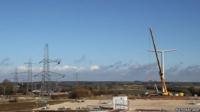
The first new design of an electricity pylon in almost 90 years has been erected at a site in Nottinghamshire.
After the best part of a century of service, the traditional steel "lattice" pylon has been updated.
The "T-pylon" is shorter, standing at about 120ft (36m); the old steel giants are typically 165ft (50m).
The National Grid says it will respond to the need to harvest energy from an increasing number of lower-carbon energy sources.
The new tower can be shorter yet still capable of transporting 400,000 volts because of the way the cables are held in place.
Instead of being attached to three arms, a diamond arrangement is used to carry the cables off in one arm in a much smaller space.
Each arm has to carry 60 tonnes. With only eight main structural components plus bolts, it is easier to erect and install - taking a day rather than a week.

According to the National Grid, new pylons are needed to respond to the move away from coal and towards other forms of generation such as wind, solar and nuclear.
These new low-carbon energy sources come from different geographical locations to the "traditional ring" of coal-fired generation in the centre of England.
This test line won't be connected to the rest of the grid, it will be used to train staff and contractors.
In particular, it will be used for people to practise "stringing" the conductors (wires) on to the pylons, as a very different technique is needed.
The T-Pylon design was adopted after an international competition held by the National Grid in 2011, won by Danish company Bystrup.
The claim is that these pylons will be less obtrusive not just because of their shorter stature, but because the design allows them to "follow the contours of the land".

According to project manager Alan Large, maintenance will be easier because operators will not have to climb up the tower, they will work from elevated platforms positioned alongside it. Their smooth, impenetrable surface will also make them more difficult to vandalise.
It won't replace the 88,000 lattice pylons that currently bestride the UK countryside. It will principally be used in the construction of new power lines in England and Wales.
The National Grid is applying to use them to connect the new Hinkley Point C nuclear power station to the UK's electricity transmission network.
The start of the UK's electricity transmission network began with the building of the first pylon in 1928 near Edinburgh.
Follow Claire on Twitter.
Anda sedang membaca artikel tentang
First new pylon type constructed
Dengan url
http://beritaberbagiceria.blogspot.com/2015/04/first-new-pylon-type-constructed.html
Anda boleh menyebar luaskannya atau mengcopy paste-nya
First new pylon type constructed
namun jangan lupa untuk meletakkan link
First new pylon type constructed
sebagai sumbernya
0 komentar:
Posting Komentar